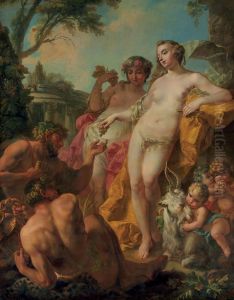Pierre Charles Le Mettay Paintings
Pierre Charles Le Mettay was a French artist born in 1726, whose work is often associated with the Rococo movement, a style that emphasized lightness, elegance, and the use of curvilinear forms. Despite his relatively short life, Le Mettay made a significant impact in the French art scene of the 18th century before his untimely death in 1759. His contributions are particularly noted in the realms of painting and engraving, where he managed to blend classical themes with the ornate qualities of Rococo.
Le Mettay's early life was marked by his immersion in the artistic environment of Paris, where he likely received his training. The details of his education are somewhat obscure, but it is known that he was active in Paris's vibrant art community, where he absorbed the influences of contemporary masters and the classical antiquity that was revered during his time. His works often reflected the hedonistic lifestyle of the French elite, depicting pastoral scenes, mythological narratives, and leisure activities with a delicate and refined touch that was characteristic of the period.
Despite the brevity of his career, Le Mettay's artistry was recognized by his contemporaries. He exhibited several works at the Salon, the official art exhibition of the Académie des Beaux-Arts in Paris, which was the primary venue for artists to gain exposure and acclaim during the 18th century. His engravings and paintings were praised for their intricate detail, harmonious compositions, and the lively portrayal of subjects. However, due to his early death at the age of 33, much of his potential remained unfulfilled, leaving the art world to wonder what contributions he might have made had he lived longer.
Today, Pierre Charles Le Mettay is remembered as a talented artist whose life and work encapsulate the essence of the Rococo movement. While his output was not as prolific as some of his peers, his existing works continue to be studied and admired for their beauty and craftsmanship. Le Mettay's legacy is that of a promising artist whose brief career offered a glimpse into the richness of 18th-century French art, making him a figure of enduring interest to art historians and enthusiasts of the period.
